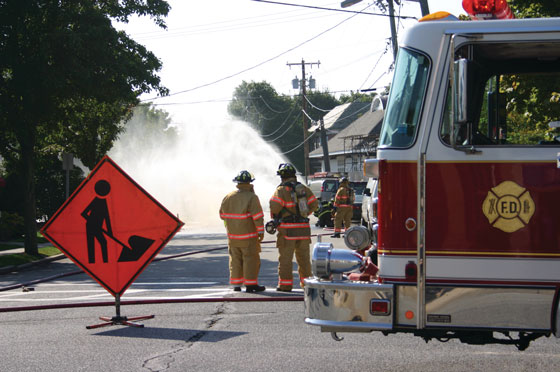| View in browser > |
 |
| Responding to excavator‑caused pipeline damage |
|
Excavation activities are the leading cause of natural gas pipeline damage. Whether a homeowner dents a service lateral with a shovel or a construction crew ruptures a gas main with a backhoe, fast and safe action is required to protect lives and property. Follow these guidelines when responding to excavation‑related gas pipeline emergencies. |
|
|
| Notify National Grid |
| Whether or not gas is leaking, ensure your dispatcher has contacted National Grid for any incident involving a natural gas pipeline. Even a slight gouge, scrape or dent to a pipeline or its coating may cause a break or leak in the future. Dispatch should report ALL gas line contacts to National Grid so that crews can inspect the line and make the necessary repairs. |
| Approach cautiously |
| Approach the incident scene cautiously, wearing full PPE and SCBA. Stage apparatus upwind, a safe distance away from the hazard area. (If a natural gas leak has been reported, use a staging distance of at least 330 feet.) Park safely out of the collapse zone of involved structures and away from manhole covers and storm sewer grates. |
|
| Assess the hazard |
| Obtain the best information possible from reporting parties through a direct interview. If the excavator is not at the scene and the location of the pipeline damage is not apparent, look for indications of digging, such as upturned soil, excavation equipment, fresh ground disturbances or yellow locate marks. Be alert for one or more signs of a gas pipeline leak: a distinct sulfur-like odor; a hissing, whistling or roaring sound; dirt spraying or blowing into the air; or continuous bubbling in water. |
| If a gas leak is confirmed, keep in mind that natural gas is lighter than air and will rise and disperse if it is not confined. A hazard occurs when gas is confined or presents in sufficient volume that its concentration lies within the flammable/explosive range of 5 to 15 percent gas in air. If you have been trained to do so, use a combustible gas indicator (CGI) to confirm the location of a gas leak and whether it poses an explosion risk. Gas can rapidly migrate into buildings, sewers and underground vaults, so check all entry points in the vicinity. |
| Evacuate appropriately |
| If air monitoring reveals the presence of natural gas in the area, establish an evacuation zone of at least 330 feet, divert traffic to minimize ignition sources, and create an appropriate exclusion zone. National Grid can assist in determining if a larger evacuation radius is needed based on pipeline size, pressure and other factors. |
| Minimize ignition risks |
| Make sure everyone at the scene of a confirmed or suspected gas leak follows these precautions to avoid creating a spark: |
| • |
 |
Eliminate open flames, cigarettes (including e-cigarettes or vape pens) and spark-producing equipment. Use only intrinsically safe radios and flashlights. |
|
| • |
 |
Do not ring doorbells or use garage door openers. Knock instead. |
|
| • |
 |
Do not step on doormats or shuffle across carpet. Friction from boots could create a spark of static electricity. |
|
|
|
|
 |
 |
| Do not try to stop the flow of gas |
| Never attempt to close valves on underground gas pipelines. These valves should only be operated by trained National Grid personnel. |
| Never bury a damaged pipeline or otherwise attempt to stop the flow of gas. If an excavator has cut a polyethylene natural gas pipeline, do not move or even touch the pipe. The normal flow of gas through this type of pipeline can generate static electricity. If you try to move, bend or crimp the pipe, it may discharge an electrical spark that could ignite leaking gas. |
| Let a gas pipeline fire burn |
| If leaking gas ignites, let it burn until the gas can be shut off at the source. Extinguishing a fire that originates from a natural gas pipe may allow unburned gas to collect and cause an explosion. (While natural gas is burning, it cannot explode.) |
| Never spray water on flames that originate from a gas pipe. Spraying water into natural gas lines can flood gas piping, knocking out pilot lights and leading to a gas accumulation problem downstream. |
 |
 |
| During rescue operations, you may use multiple overlapping fog streams to protect the rescue team and direct the body of the fire. Do NOT use solid or straight stream nozzles on or near any natural gas pipe. You may use a fog spray to cool combustible exposures if it is safe to do so. You may also use water to extinguish all open flames not originating from a gas pipe. |
| Promote the 811 service |
| Advise the public to always notify their local 811 service a few days before any digging project to have underground utilities located and marked. This free service prevents the majority of pipeline strikes. |
| Keep yourself, your team and the public safe this summer and year‑round. Visit firstresponder.ngridsafety.com today to register and complete your FREE utility safety training. |
|
|
|
| |
| |
|
| To report emergencies, call 911 and National Grid immediately. |
| |
 |
| In case of gas emergencies: |
 |
Long Island and the Rockaways:
911 and 1‑800‑490‑0045 |
 |
Metro New York:
911 and 1‑718‑643‑4050 |
 |
Upstate New York:
911 and 1‑800‑892‑2345 |
 |
Massachusetts:
911 and 1‑800‑233‑5325 |
 |
| |
|
|
|
|
| |
|
|
|
| |
| |
|
 |
#14791 © 2024 Culver Media, LLC |
|
| |
|
|
|
 |
|
|